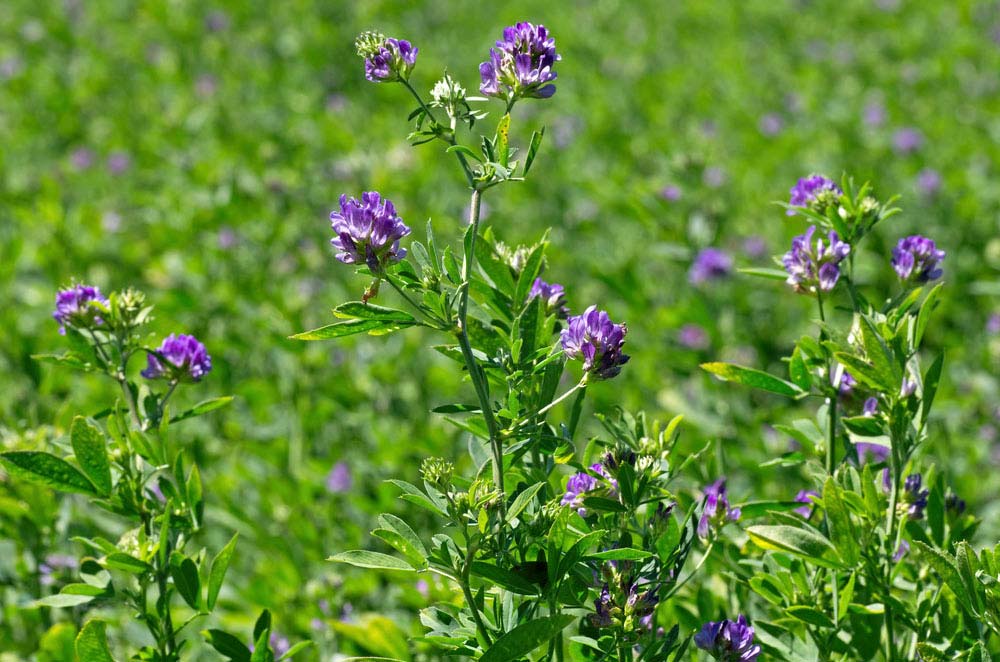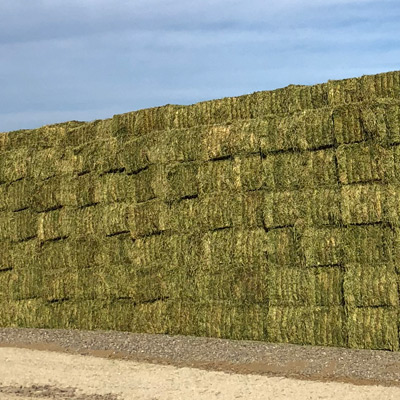What is Alfalfa?

Alfalfa is an exceptional plant. Alfalfa, (Medicago sativa), also called lucerne or purple medic, perennial, cloverlike, leguminous plant of the pea family (Fabaceae), widely grown primarily for hay, pasturage, and silage. Alfalfa is known for its tolerance of drought, heat, and cold and for the remarkable productivity and quality of its herbage. The plant is also valued in soil improvement and is grown as a cover crop. It’s considered a forage legume, a type of plant that grows in pods. Other legumes you may be more familiar with include beans, peanuts, and peas. Alfalfa can grow to a height of 36 inches and has an extremely deep root system.
The roots allow it to survive in particularly difficult conditions such as drought. The primary root of alfalfa can attain great depths, an adaptation for drought tolerance. In porous subsoils, taproots as long as 15 metres (50 feet) have been recorded in plants over 20 years of age. The roots of seedlings also grow rapidly, reaching soil depths of 90 cm (3 feet) after two months and 180 cm (6 feet) after five months. Newly established fields of alfalfa often survive severe summer drought and heat when other leguminous plants with shallower and more-branching roots succumb. These long taproots also improve soil quality by decreasing soil compaction. Alfalfa hay is harvested starting in early spring in southern states such as Arizona, and usually begins in May in northern Pacific Northwest states. Fields are cut several times each season, up to eight times in warmer growing regions. Nutrition is at its highest when Alfalfa is cut pre-bloom.

Ideal Forage:

Alfalfa has a remarkable capacity to rapidly regenerate new stems and leaves following cutting. As many as 4 – 5 crops of hay can be harvested in a single growing season in the Pacific Northwest because of this abundant regrowth. The frequency of harvest and the total seasonal yields depend largely on the length of the growing season, the adaptability of the soil, the abundance of sunshine, and especially the amount and distribution of rainfall or irrigation during the growing season. Green leafy alfalfa hay is very nutritious and palatable to livestock, containing about 16 percent proteins and 8 percent mineral constituents. It is also rich in vitamins A, E, D, and K.
Alfalfa in particular is high in energy and is an excellent source of vitamins and minerals. When properly cured, alfalfa is the best of the legume hays from a nutrient standpoint. It has the most feed value of all the perennial pasture forages. Alfalfa is used for horses, dairy cows, beef cattle, sheep, chickens, turkeys and other farm animals. Why is this important to the non-farmers among us? Alfalfa is particularly important to the Dairy Farmer, which means its even valuable for the Ice Cream admirer. By using Alfalfa for dairy cows’ feed, milk production is now 60% more per cow than was possible just 50 years ago. Alfalfa can be directly attributed to the higher production capacity of ice-cream, cheese, and butter due to its high quality and richness of nutrients.
INTERESTING FACTS
- Did you know Alfalfa was domesticated over 6000 years ago. In fact, some of the oldest evidences of Alfalfa usage is found in Iran.
- Some endangered species and hundreds of animals use Alfalfa for their habitat.
- There are Alfalfa Breeders who have developed several varieties of Alfalfa. Some are very resilient and resistant to insects and other pests which reduce the need for pesticides.
- The United States’ farmers produce more than 60 million tons of Alfalfa every year. California leads the way followed by Idaho and Montana as top producing States.
- Alfalfa wasn’t widely grown in the United States until 1849 though early colonists (including George Washington and Thomas Jefferson grew a few acres on their own farms.
- Alfalfa, rich in nutrients, is often used for many kinds of Zoo animals around the world.
- Alfalfa crops can be cut up to 11 times and can live in fields for 25yrs.
- Do you love Honey? Blossoms on the Alfalfa plants are used by Bees to make honey.
- Ever wonder if Alfalfa produces seeds? There are 200,000 seeds in just one pound (1lb) of Alfalfa.
- Say Alfalfa 5 times fast… the name “Alfalfa” comes from Arabic words meaning “Best Horse Fodder” or “Horse Power”
- Thus… along with grains like Oats… Alfalfa is a staple feed for race horses, camels, and other very athletic animals.
